Screw Conveyors
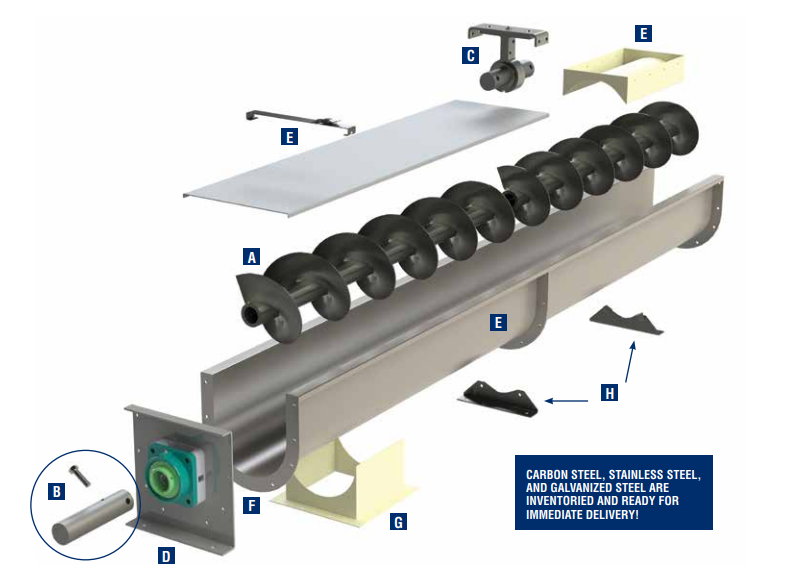
(A) Conveyor Screw: Compact, manufactured straight and accurate in helicoid, section, ribbon, and special designs to meet your requirements.
(B) Job-Rated Components: Selected to meet the performance that you require. Precisely manufactured to ensure a longer-lasting and better running unit.
Jig-Drilled Couplings: Assures easy shaft alignment and assembly. Available with "Redi-Change" clamping key for quick disassembly of a conveyor screw.
Tem-U-Lac Self-Locking Coupling Bolts: Protects against system damage and costly downtime caused by coupling bolts or nuts working themselves loose.
(C) Hangers and Bearings: Various styles and bearing materials selected to meet your specific needs.
(D) Trough Ends: Many bearing and seal styles are available to match your needs.
(E) Troughs, Covers, Clamps, and Shrouds: Durably constructed standard "U" and other styles of troughs including tubular. Covers, clamps, and shrouds are available for all applications.
(F) Nu-Weld® Flange: Continuously welded steel flange holds trough in alignment.
(G) Discharge Spouts: All types/styles available and located where you need them. Available for hand, electric, hydraulic, and pneumatic powered gates.
(H) Supporting Feet and Saddles: Align and fasten the trough to the floor or other existing structure.
Applications
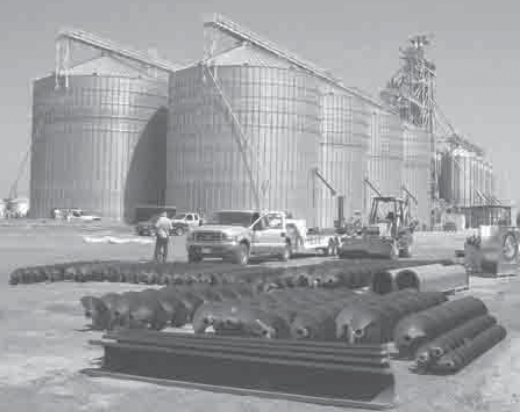
- Typical Installation of screw conveyors at a large grain storage facility.
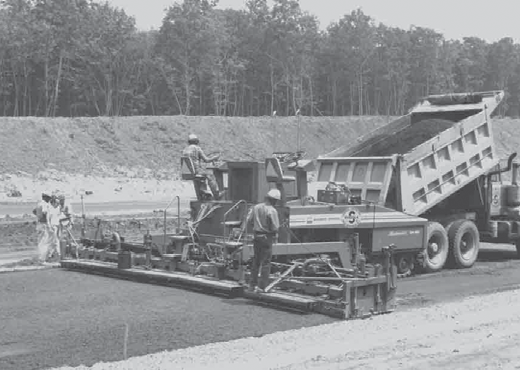
- This Matchmaker asphalt finisher uses a Screw Conveyor at the back of the tractor unit to move material outward in both directions and to spread it evenly across the entire paving width.
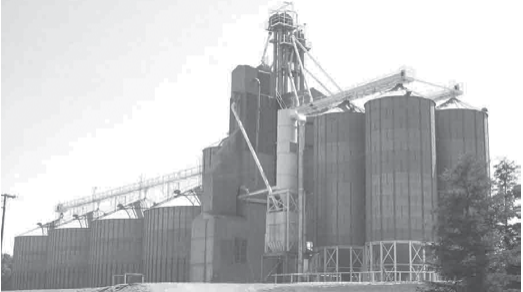
- Screw Conveyor system and SCC Bucket Elevators being used for speed grain handling in a large facility. Two screw conveyors, running over two rows of tanks are 494 feet long. Has a double hanger in the center so each half is powered independently. Between the two rows of tanks, a collecting screw conveyor, also with a double hanger at the center, is 528 feet long. The system handles whole grains at approximately 100 tons per hour
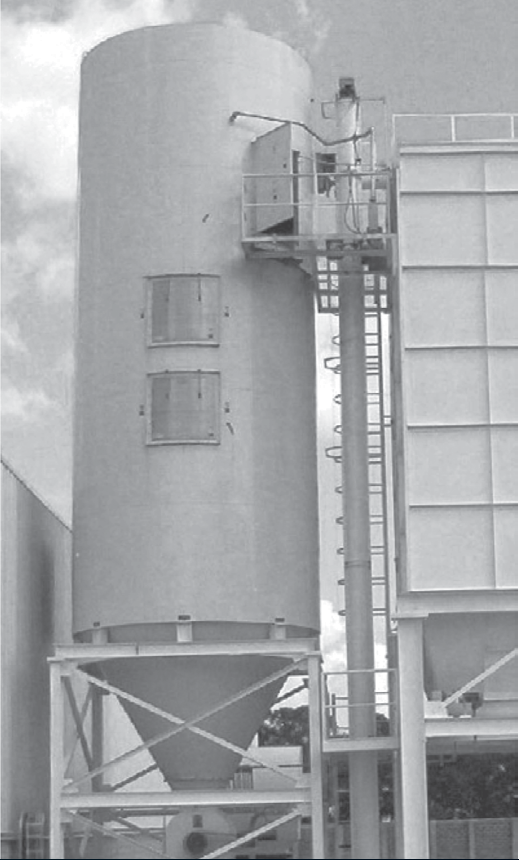
- The Screw-Lift does an efficient elevating job as part of a complete Screw Conveyor system. The Screw-Lift illustrates the compact arrangement possible when space is limited.
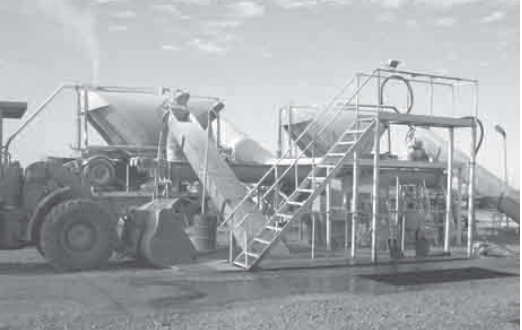
- Screw Conveyors are used for conveying multiple materials including wet and dry. This application demonstrates how liquid material can be conveyed up an incline for ease of loading trucks. All parts of the system are enclosed, yet readily accessible.
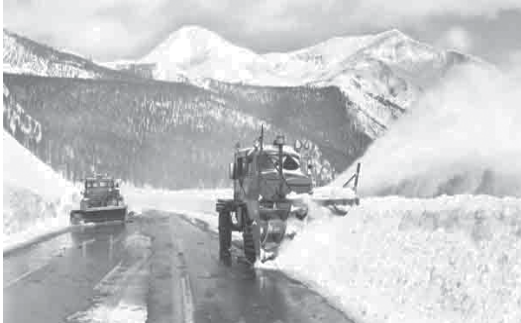
- Special flighting provides fast and clean snow removal. This type of flighting has been used since 1932.
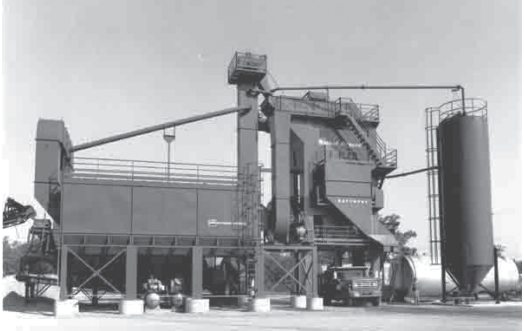
- This asphalt fabric filter type dust collector uses Screw Conveyor flighting in the hoppers which returns collected fines to the mix.
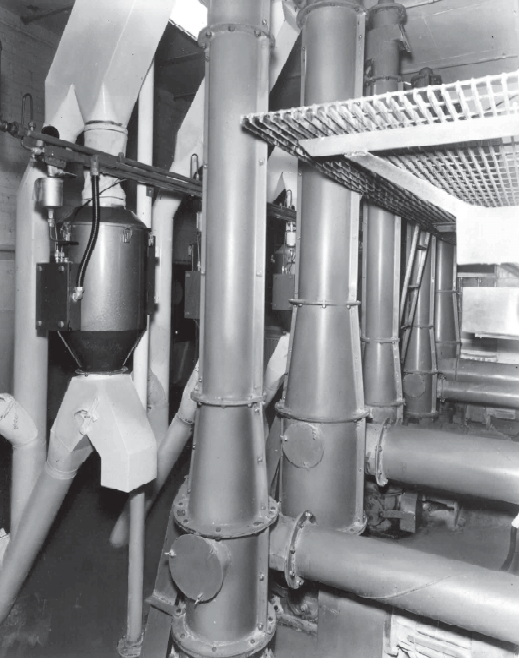
- Rubber reclaiming operations (like the one shown above) use high capacity, compact Screw-Lift and screw conveyor systems to transport rubber back and forth between mills and screeners.
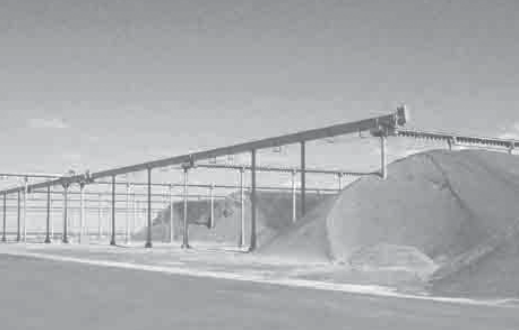
- Partial view of a large outdoor installation utilizing leveling screws to distribute material evenly across the storage area.
Components of a Screw Conveyor System
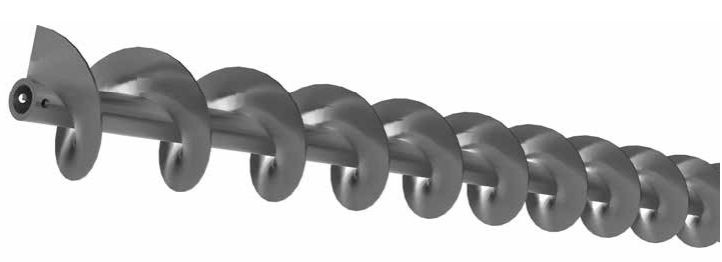
The Conveyor Screw: Transmits smooth positive motion to the material as it rotates within the trough.
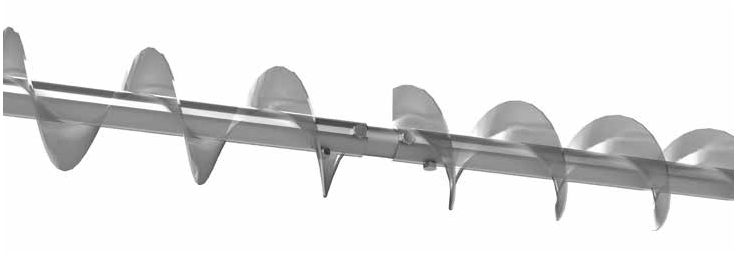
Couplings and Shafts: Connects and transmits motion to subsequent screw conveyors. This is held in place by self-locking Tem-U-Lac bolts
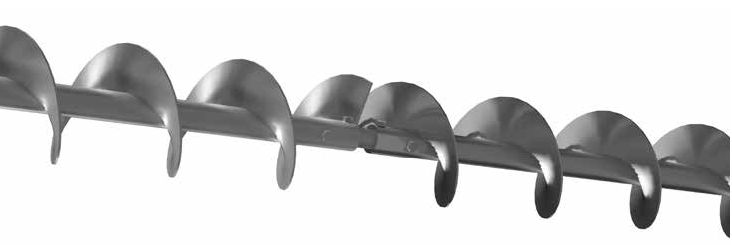
Redi-Change Sections: This component allows an individual conveyor section to be lifted out without disassembling adjacent parts or components. This is an optional feature available at an additional cost.
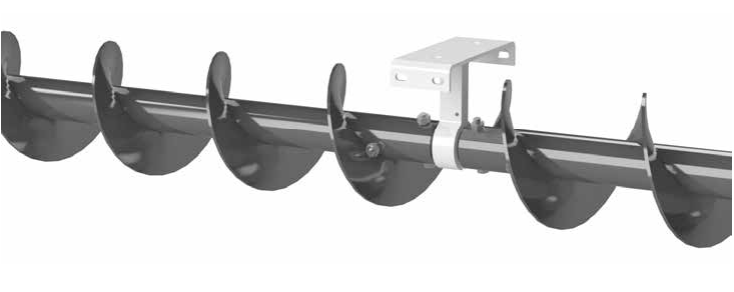
Hangers: Provide support, maintain alignment, and serve as bearing surfaces.
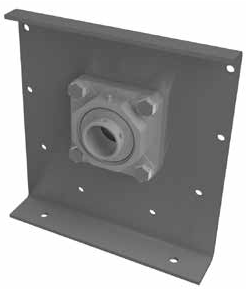
Trough Ends: Support the conveyor drive and end shafts while maintaining trough alignment. Can be provided with your choice of bearings or thrust bearings.
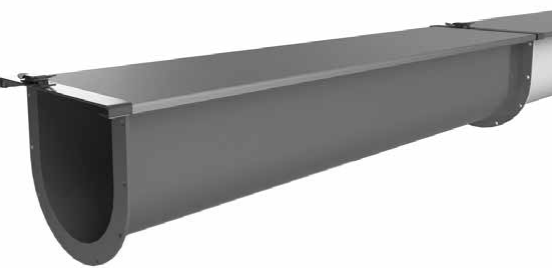
Troughs and Covers: Completely enclose the material being conveyed as well as the rotating parts. Covers are available in various styles and are secured to the trough by Spring, Screw, Tite-Seal, or quick-acting Barron Clamps depending on the trough cover combination used.
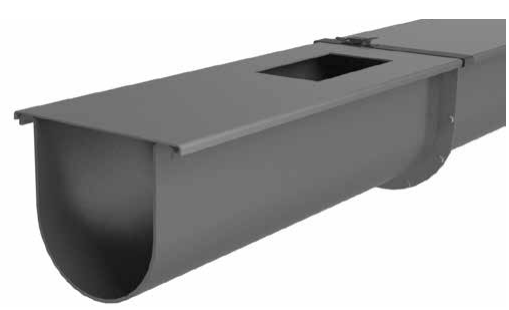
Inlet and Discharge Openings: Can be located wherever needed. Discharge spouts may be without slides or equipped with either flat or curved slides. These slides may be operated by hand, rack and pinion gears, or power.
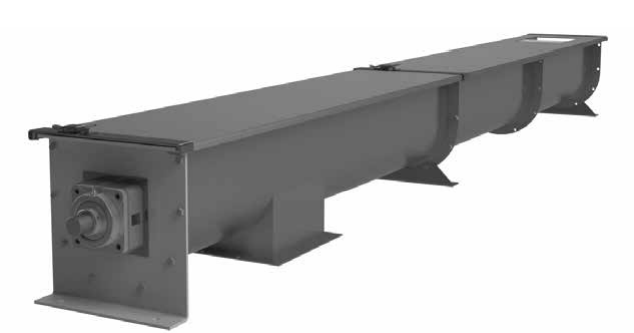
The Complete Screw Conveyor Unit: This is supported by the trough end as well as by Feet or Saddles placed at intermittent locations on the unit. The screw conveyor is one of the most economical conveyor types available for moving bulk materials. The screw conveyor unit is fully enclosed in order to contain the moving material and its' atmosphere. The standard unit (with variations in design) is suitable for providing solutions to a wide variety of bulk material handling problems.
Design Data
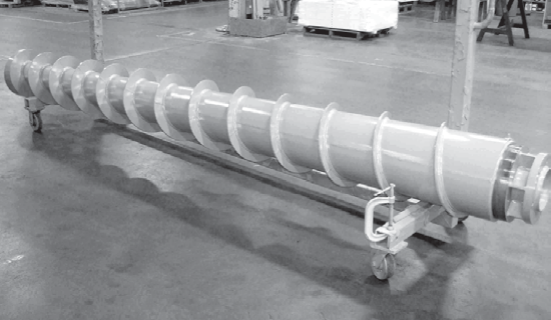
Engineering and Layout
This section contains all pertinent engineering data and procedures for prescribing and specifying the important details and features of most conveyor installations. Please feel free to contact us if you have any questions or if you need assistance with designing your screw conveyor system.
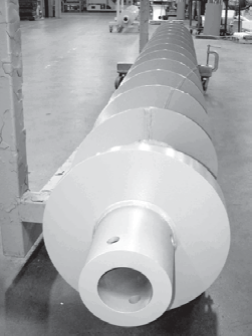 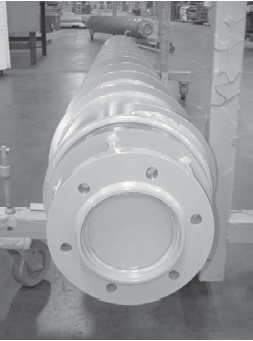
Material Analysis
The first step in engineering a Screw Conveyor is to analyze the physical characteristics of the material as well as the rate in which the material is to be handled.
The capacity of a Screw Conveyor should be defined in terms of cubic feet per hour. It is also important to determine the maximum capacity the conveyor will be required to handle. The capacity is most often stated in terms of tons or pounds per hour. That being said, the material to be handled often varies in density, therefore, the maximum volume or capacity in cubic feet per hour is the maximum pounds of material per hour divided by the minimum possible density of the material. It is volume to be conveyed which determines a conveyor's size and speed.
Physical properties of the material to be thoroughly understood are the following:
1. Maximum lump size and the percentage of lumps to the total volume along with the minimum particle size and, if possible, a screen analysis.
2. Flowability characteristics. This term is related to the angle of repose.
3. The abrasive quality of a material can be defined by knowing its hardness
on a Moh’s scale. If this is not available, compare your material with
another known abrasive material
4. Additional factors which affect conveyor operation and design are further
discussed below and are shown in the Material Classification table, also below.
**Note: Moisture content, while not accounted for in the material table, will affect the flow characteristics and density of a material. Some material, when very dry or very wet, will tend to have unfavorable flowability characteristics. When the moisture content is between these two extremes, such a
material may be quite sluggish and have a high angle of repose. Where this is a
possibility, the material should be re-classified. Conveyor design and selection
should proceed with the full knowledge of all conditions that can prevail in order to provide you with a system that will best meet your needs.
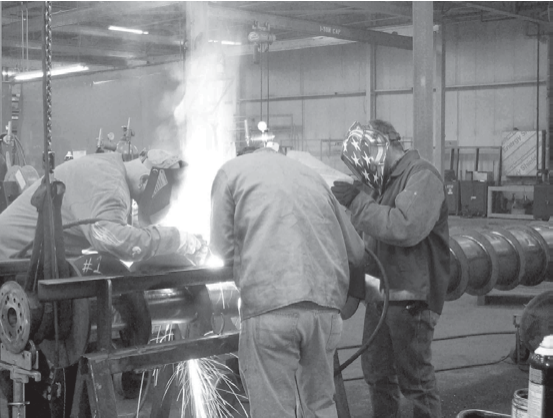
Engineering
No machinery design is complete without considering its usage. For example, a conveyor
that will be used intermittently for two hours a day does not have to be built
as heavily as one that will operate twenty-four hours per day. Likewise, shock
loads will affect the consideration given on gauge of steel used as well as drive
equipment. Treatment of these factors and their affect on conveyor design are
not discussed here in sufficient enough detail, but please contact us so that we can determine your best conveyor design.
Since the Screw Conveyor selected is based on a maximum volume control
of material to be handled, surge loads, overloads and choke feeding must be
accounted for in the conveyor design. Screw feeders are popularly used for this
control.
Classify Your Material
Materials are classified in the chart below. If you specific material is not listed, it can be classified by comparing it with similar materials that are listed on the chart. If necessary, your material can be classified by referring to the material classification chart below.
Establish Required Diameter and Speed
After you know your material classification and required capacity, refer to the capacity chart below (note: you can use the command CTRL + F to search for these different charts). Your material classification indicates which trough loading applies. Select the size for your capacity using the smallest diameter conveyor that is below the maximum recommended speed. After size is determined the exact conveyor speed is determined by dividing the required capacity (in cubic feet per hour) by cubic feet per hour at 1 revolution per minute (RPM).
**Note: If handling a material with hard lumps (lumps will not break up in the screw conveyor) please refer to the chart directly below. If the required diameter (as found above) is smaller than the recommended size give in the lump chart, use the conveyor diameter from from the chart directly below and determine the RPM from capacity farther below.
Maximum Size of Lumps, Inches
|
Ratio
Lumps to Total Volume
|
Diameter of Conveyor, Inches
|
|
4
|
6
|
9
|
10
|
12
|
14
|
16
|
18
|
20
|
24
|
|
Lumps 10% or Less
|
1.0
|
1.5
|
2.5
|
2.5
|
3.0
|
3.5
|
4.0
|
4.5
|
5.0
|
6.0
|
|
lumps 20% to 25%
|
0.5
|
0.75
|
1.5
|
1.5
|
2.0
|
2.5
|
3.0
|
3.0
|
3.5
|
3.75
|
|
All Lumps
|
0.3
|
0.5
|
0.75
|
0.75
|
1.0
|
1.25
|
1.5
|
2.0
|
2.0
|
2.5
|
Component Group Classification
As shown in the material table below, each material is assigned to a component group. These component groups factor in the material's physical characteristics and then match these with the proper conveyor components. A description of these components in each group can be found in the component group specifications chart below.
Please note that the Babbitted bearings are considered standard where contamination from required lubricants is not a factor. Oil impregnated wood or nylon bearings are often recommended where lubricant contamination is a factor. Ball bearings are not recommended for use in conveying gritty or very fine materials which might penetrate the oil seal. For abrasive applications involving high temperatures, hard iron bearings are normally used. Other types of bearing
materials furnished upon request.
Establish the "D" Factor
The "D" Factor is a constant applied to the particular Component Group of a given conveyor. To Establish the "D" Factor, locate your conveyor diameter and bearing material in the table directly below. The figure appearing at this intersection is to be used as "D" in the horsepower formula.
Table of Factors "D"
|
Size of conveyor, Inches
|
Type of Hanger Bearings
|
|
Ball or Roller
|
Wood, Babbitt, Nylon, or Molded Fabric
|
Self-Lubricating Bronze
|
White Iron or Manganese Steel
|
|
3
|
10
|
15
|
24
|
35
|
|
4
|
12
|
21
|
33
|
50
|
|
6
|
18
|
33
|
54
|
80
|
|
9
|
32
|
54
|
96
|
130
|
|
10
|
38
|
66
|
114
|
160
|
|
12
|
55
|
98
|
171
|
250
|
|
14
|
78
|
135
|
255
|
350
|
|
16
|
106
|
186
|
336
|
480
|
|
18
|
140
|
240
|
414
|
600
|
|
20
|
165
|
285
|
510
|
700
|
|
24
|
230
|
390
|
690
|
950
|
Establish The Required Horsepower
The formula stated below provides the horsepower (HP) required at the conveyor drive shaft for a standard conveyor.
H= [(D x S + Q x F)] / (1,000,000)
Additional power will be required for starting under load, overcoming choke loads or other unusual conditions. There is also a loss of power through the drive machinery from 10% to 15%. To compensate for these factors, the formula for the required motor horsepower is divided by .90. This is Step No.1
Where:
L = Overall length in feet
D = Bearing Factor (see "D" factor table)
S = Speed in RPM (see capacity chart)
Q = Quantity of material being conveyed in pounds per hour (LBS/HR)
F = Horsepower factor "F" (see Material Tables)
Step No.2
Motor Horsepower = H x P
P = 2 when H is less than 1
P = 1.5 when H is between 1 and 2
P = 1.25 when H is between 2 and 4
P = 1.1 when H is between 4 and 5
P = 1 when H is greater than 5
Step No.3
HP = Minimum Recommended Horsepower .90
Conveyor Horsepower Ratings
One of the factors that must be considered at this point is the required horsepower. Check the required horsepower using the above formula against the torque and horsepower capacity limitation for each conveyor pipe and shaft size.
Use the table directly below, which shows the maximum allowable horsepower at various conveyor speeds.
Example: a 9" conveyor mounted on 2" standard pipe, bushed for 1 1/2"
diameter couplings, is limited to a maximum of 5 HP at 100 RPM. If, in a given
application, a larger motor is required, it is then necessary to use a 9" conveyor
mounted on 2 1/2" pipe, bushed for 2" diameter couplings. You will see that this
arrangement is rated at 12 HP at 100 RPM or 6 HP at 50 RPM. These ratings
are on the basis of two coupling bolts at each end of the conveyor pipe. In some
sizes three bolts can be used to increase the drive limitation shown. Contact us for specific recommendations if in doubt or if you have any questions
Horsepower Ratings
| Size of Conveyor, Inches |
Pipe Size, Inches |
Coupling Diameter |
Max, HP @125 RPM |
Max, HP @100 RPM |
Max, HP @75 RPM |
Max, HP @50 RPM |
| 6, 9, and 10 |
2.0" |
1-1/2"
|
6.25
|
5.0 |
3.75 |
2.5 |
| 9, 10, and 12 |
2.5" |
2.0" |
15.0 |
12.0 |
9.0 |
6.0 |
| 12 and 14 |
3.0" |
2-7/16" |
18.75 |
15.0 |
11.25 |
7.5 |
| 12, 14, 16, 18, and 20 |
3.5" |
3.0" |
30.75 |
24.6 |
18.50 |
12.3 |
| 20 and 24 |
4.0" |
3-7/16" |
43.75 |
35.0 |
26.25 |
17.5 |
Sample Problem
Establish the conveyor size, speed, horsepower, and other specification necessary for conveying 1,800 bushels of dry, clean wheat per hour for a distance of 50ft.
Solution
- Refer to the material table below
*Note: Average weight/cu. ft. of wheat is 454-48 lbs.
- The material classification is 47C ½ 25N
- The recommended types of conveyors are 1A, IB, and 1C
- The "F" Factor is .4
The material classification, C ½ 25N indicates the material is granular — 1/2"
inch and under, very free flowing — angle of repose up to 30°, non-abrasive
and contains explosive dust. The recommended types of conveyors, lA, 1B, 1C
indicate the group that is designed for normal service. (See the "component group specifications" table below)
Convert the given capacity from bushels per hour to cubic feet per hour. Known:
there are 1.25 cubic feet in a bushel of wheat. Therefore, 1,800 x 1.25 equals
2,250 cubic feet per hour. Now, 2,250 cu. ft. per hour x 48 Ibs. equals 108,000
lbs./hr. This will be assumed to be the maximum desired capacity. Reference the
Capacity Chart below and establish the conveyor diameter and
proper speed. As you will note C25 material class has a 45% recommended
trough loading and 2,250 cu. ft./hr. requires a 12" diameter screw conveyor
operating at 116 RPM (EXAMPLE: 2,250/19.4 = 115.9 or 116 RPM.)
*Remember,
do not exceed the maximum recommended speed without first consulting with
our staff engineers. If hard lumps had been present, we would now consult the "Maximum Size of Lumps" table above.
We know that:
L = 50 feet
D = 96 (see "D" Factor table) (12" conveyor with wood bearings)
S = 116 RPM (See Capacity Chart)
Q = 108,000 lbs./hr.
F = .4 (see Material Tables)
Now, inserting these figures in the formula:
H = 50(96 x 116 + 108.000 x .4) / 1,000,000
Therefore: H = 2.8
Motor Horsepower equals H x P (see value of P under formula)
Therefore: 2.8 x 1.25 = 3.5
To be assured that you have sufficient power, divide the HP by .90. This gives you a minimum recommended horsepower of 3.9. Your minimum choice of motor size would, therefore, be 5 HP
Now, refer to the Torque Capacity / Horsepower Ratings table and note the minimum pipe size for a 12" conveyor is 2-1/2". Maximum allowable horsepower for this conveyor's specifications is 15 HP. Since this figure is in excess of our requirements, we can use the computed 5 HP motor.
Additional Screw Conveyor specifications for indoor operation will be:
- Group Classification: 1A
- Conveyor Size and Speed: 12" at 120 RPM
- Conveyor Screw: 12" Standard Helicoid
- Conveyor Trough: 12" No. 12 gauge steel, Double Flange Construction, Flanged Cover and Barron Clamps
- Type of hanger bearings: 12" x 2" bore, intermediate
hanger with babbitted bearings
Special Applications and Specifications
The selection procedure, outlined above, takes into account the material’s
physical characteristics, provides for the proper cross-section loading of a
conveyor and specifies, through the component tables, the type of conveyor
components to be used. Some material’s physical characteristics will require
additional special features.
Abrasive Materials
Abrasive materials often cause excessive wear on Screw Conveyor
components and should be carried at low cross-sectional loads and at relatively
slow conveyor speeds. For conveyors which will handle extremely abrasive
materials or will be subjected to heavy or continuous service, heavy-duty
components should be specified. Heavier than standard, surface-hardened
or abrasive resistant steels are available for this application.
There are also some materials that are normally considered abrasive which
may easily become aerated, thus reflecting a minimum density and greater
flowability. Here it is possible to use higher speeds and in some cases, higher
cross-sectional loads. Judgment and experience, however, will dictate the
conditions when this can occur.
Contaminable Materials
When handling easily contaminable materials, such as food products or
some chemicals, it is possible to specify components and other features of
construction which were not necessarily included and made a part of the
conveyor selection process. These features would include non-lubricating type
intermediate hanger bearings, seals under the end bearings, easily removable
trough covers and, possibly, drop bottom conveyor trough construction.
Accessibility to the internal parts of the conveyor through the use of some of
these features means the conveyor can be easily inspected and cleaned out.
Conveyor Flighting may be continuously welded to the conveyor pipe on either/
or both sides of the flight. Grinding and cleaning of the welds can remove scale
and/or roughness that could contribute to contamination.
Corrosive Materials
When handling bulk materials which are corrosive, conveyor components
manufactured from stainless steel, aluminum or other special alloys are
available, also hot dipped galvanized carbon steel components may be used in
non-abrasive applications.
Degradable Materials
Materials which tend to break or separate easily, affecting quality, may be
handled in larger diameter, slower turning Screw Conveyors to reduce agitation.
Extreme Temperatures
Materials may be heated or cooled while being conveyed in a jacketed conveyor.
When handling materials in extreme temperatures, specify Screw Conveyor
components of metal alloys designed to meet these conditions.
Fluidizing Materials
When agitated, some materials tend to “aerate” and react similar to a liquid.
When handling these materials, it is important to know the aerated density so
that conveyor size and speed will be based on the larger aerated volume. When
a volumetric type feeder is used, the horsepower should he based on the design
volume and maximum material density.
Mixing Materials
If the materials are to be mixed or agitated while being conveyed, ribbon
flights, cut flights, cut and folded flight or one of the above in combination with
paddles, may be used.
Materials Which Pack and Resist Digging
Some materials have very strong resistance lo digging which means that it
is difficult, and in some cases, impossible to shear a pile of the material or
to penetrate it with a sharp edge such as in a conveyor flight. Offsetting the
conveyor screw and placement of an angle inside the trough on the carrying
side will enable some of these materials to be handled.
Occasionally, materials tend to pack under pressure and become hard in the
clearance between the conveyor screw and trough. Some of these materials can
then be conveyed satisfactory if the Screw Conveyor is operated at low speeds
and the edge of the flight is used as a cutting edge.
Hygroscopic Materials
Materials which readily absorb moisture are hygroscopic. Such materials
become less free flowing as they absorb moisture. This factor must be
taken into account when determining conveyor size, HP and speed. Some
hygroscopic materials can, as they absorb moisture, change in density and
angle of repose and thus, effect the material classification number.
Toxic Materials
If harmful vapors or dust are released by agitation and conveying, the system
should be of sealed construction.
Viscous or Sticky Materials
Viscous materials can best be handled by Ribbon Conveyors because they
usually have a tendency to stick and adhere to the joint of the conveyor pipe
and flight on a standard conveyor.
Material Classification

Component Group Specifications
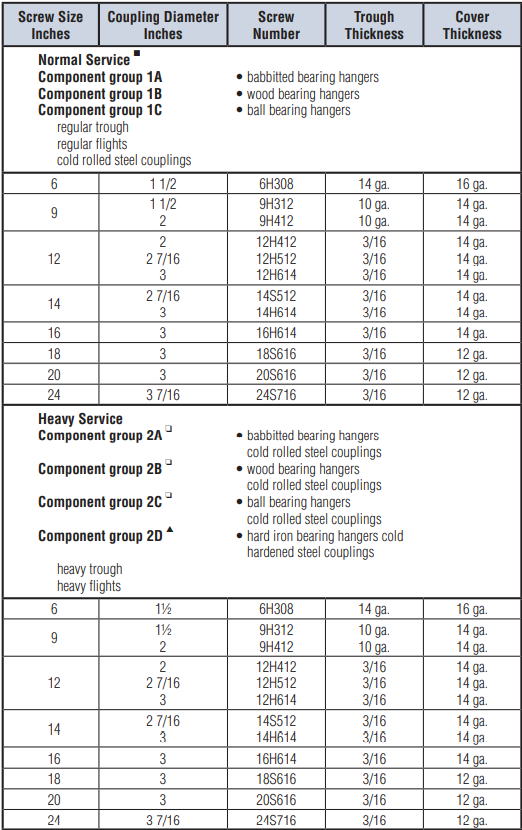
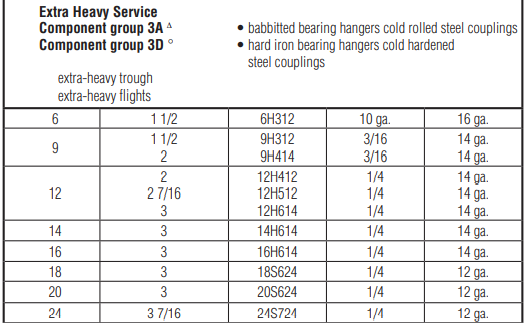
■ For use with non-abrasive materials.
◻ For use with nonabrasive irregular material
or lumpy material containing lumps over 1/2"
▲ For use with mildly abrasive material.
∆ For use with mildly corrosive materials.
°
For use with very abrasive materials.
|
|
Material Data Table
For quicker searching throughout the chart, you can use the search functionality on your computer's keyboard.
Windows: CTRL + F
Mac: command + F
Note: reference to specific materials in the table should not be construed as indicating that all materials are recommended for screw conveyor applications. Consult with our customer service team for additional assistance.
|
|
|



